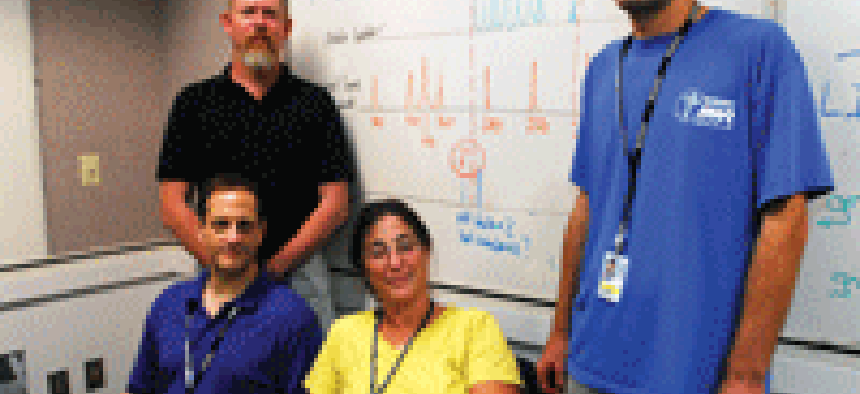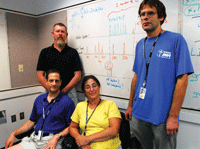Authorities in Louisiana are still trying to identify some of the bodies'unclaimed for a year and beyond sight recognition'recovered after the floodwaters from Hurricane Katrina receded.But state police have been making progress, with help from a group of scientists from the National Institutes of Health's genetics and bio-informatics community in using DNA to help with identification.Through DNA, Louisiana has identified 153 people. About 35 remains still need to be identified. They are among the 1,200 people who lost their lives in Louisiana and Mississippi from the hurricane and subsequent floods a year ago.NIH provided software and scientists from its National Human Genome Research Institute and the National Library of Medicine's National Center for Biotechnology Information.The agency is applying quality-assessment software, called OSIRIS, developed based on experience working with DNA profiles from the Sept. 11, 2001, terrorist attacks, said Stephen Sherry, staff scientist at the National Center for Biotechnology Information. Sherry is responsible for the OSIRIS development project being used with the hurricane DNA identification program. It's the first time NIH has used the software on such a large scale.'When the state was waiting to get funding [from the Federal Emergency Management Agency], NIH was instrumental in moving the hurricane DNA identification program forward and assisted by providing software for the tracking of [DNA] sample collections,' said Captain Jerry Patrick, director of the Louisiana State Police Crime Laboratory in Baton Rouge.OSIRIS looks for artifacts and other problems in DNA profile data stored in a genetic data management system, which assists in scheduling DNA collections and organizing a family tree with DNA profiles of family members.Family members of missing persons provided swabs of their cheeks for DNA typing, while scientists took DNA or bone samples from deceased individuals. Lab results were plugged into the management software.Accurate identifications by DNA typing depend on quality assurance testing of the profiles, Sherry said.'Every asserted fact that goes into an analysis has to be checked that it is right,' Sherry said.The National Center for Biotechnology Information developed the open-source independent review and interpretation system, or OSIRIS, named after the god of the dead in Egyptian mythology, Sherry said. OSIRIS judges the interpretation of DNA typing that the lab results and genetic software make.OSIRIS, written in C++, is a procedural code that can be read in PC, Mac and Unix platforms. Instead of examining one document at a time, as many Windows products do, Osiris is a batch-oriented and high-throughput data processing system. It collates results and generates reports to management.'What it does, it does quickly. It can analyze on the order of 10,000 samples in two minutes,' Sherry said.Mass fatalities, such as the 9/11 attacks and Katrina, increase the urgency and challenge that DNA typing achieve the highest probability of identification.Software for DNA typing, however, was created to work with pristine, high-quality DNA samples, Sherry said. The fatalities in 9/11 and Katrina, however, often lacked distinguishing body marks or recognizable features, and had degraded DNA, he said.OSIRIS evolved from the group's experience building a one-time system to help identify the victims of the terrorist attacks in New York.Identification is similar to paternity testing, which might for one case involve 30 DNA samples and one analyst, who plugs the genetic data into a computer program to get the statistics and make a case as to the probability of relationship, Sherry said.With thousands to identify, a massive effort over several months was required to write a one-time application to code, record with unique identifiers through the process, and reliably track samples and data related to it to assure quality, he said. It also had to connect with New York City agency systems.'Building this system was like we had to build the plane as we were flying it, and it had to make no mistakes,' Sherry said, adding that a single mistake could result in returning the wrong remains to the wrong family.What 9/11 demonstrated was that lab software doing DNA typing with degraded samples didn't always get the call right, he said.'There was no easy way to go in and figure out what part of a DNA profile was trustworthy and what was not,' Sherry said. It was necessary to be able to look at the raw signal, or instrument measurement data, to decide if it was good or bad.'With thousands of profiles, no one has the time for that. It's a mind-numbing activity,' Sherry said, but perfect for computers.In late 2003, the NIH group began to develop the OSIRIS software to be available for future mass fatalities.The tool helps to quickly identify high-quality data sets and those that are not. It's automating a system of quality assurance testing that, until this point, was done by hand, Sherry said.'What we're doing is looking for these needles in a huge haystack of data,' he said.With OSIRIS, NIH can re-analyze the signal data and make its own calls that conform to a set of business rules for interpreting DNA and for calling a profile complete or incomplete. Then NIH gives the profile a DNA bar code number, which is compared with what the DNA software indicated.'It's essentially a triage operation looking at the reliability of the call,' Sherry said.When typing DNA, scientists evaluate 13 markers on the DNA. Any individual would have two copies of the 13 positions, one each inherited from the mother and father. These markers are four letter repeats. What varies is the number of times they are repeated in a row, he said. Each of the 13 markers has a range of variations.'It is a mini-genetic system that makes us all distinguishable if we compare one with another,' he said.In Katrina, there were almost no personal effects because everything was destroyed in the floods.'Victims had drowned and were waterlogged. After three or four days, the skin sloughs off. So you have no identifying facial characteristics,' Sherry said.Instead, scientists had to use DNA or bone typing or both for identification of the body.The floodwaters washed away medical and dental records and fingerprint identification, and displaced the community infrastructure that might have provided other local information, the state police's Patrick said.'It required detailed analysis and building complex kinships using possible family members, who were also displaced,' Patrick said.NIH helped recruit, schedule and train genetic counselors to talk with families and identify which reported missing persons were potentially deceased.'They constructed family pedigrees for those who were truly thought to be deceased and needed to have DNA testing,' Patrick said.Adding to the challenges, many families had evacuated to various states. And with blended families, some members were not directly related.The result of DNA typing for each set of remains or survivor profiled is a 26-digit bar code, which is a standardized way to express the uniqueness of the 13 markers. That is their DNA fingerprint.'And the closer all the numbers are, the more related you are genetically in principle,' Sherry said.'This is evidence that this could be Aunt Betty. It doesn't claim that it is, but it's the best evidence we have,' he said. A coroner makes the final decision whether that is sufficient or not.Sherry's training has always been theoretical, but he has been moved by the appreciation given for the profile data.'Just the gratitude I've seen from some survivors when they've had remains returned convinced me that it is the most privileged event I've had as a scientist,' he said. 'It touched me as a fellow human and a government worker to feel the gratitude and that the process worked.'
Tackling DNA: Stephen Sherry (back left), Robert Goor (seated, left), Lisa Forman (seated, right) and Janos Murvai (front, right) of the National Center for Biotechnology Information
Rick Steele







